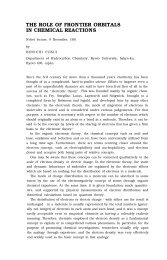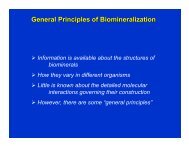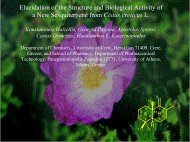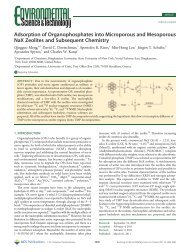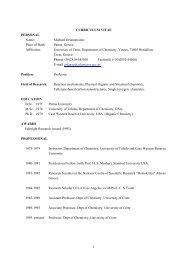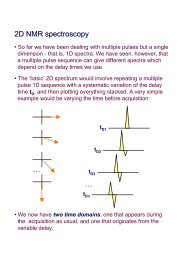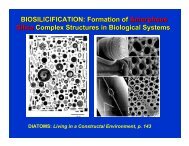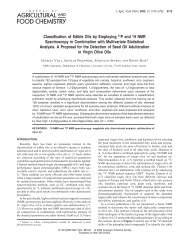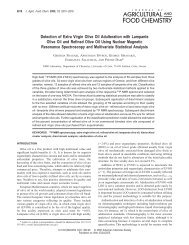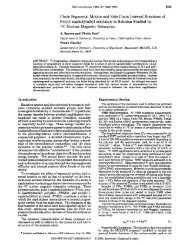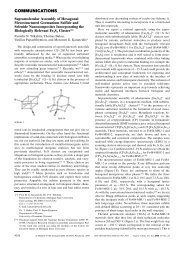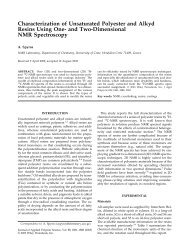J. Am. Chem. Soc., 2002, 124, 10157-10162. - American Chemical ...
J. Am. Chem. Soc., 2002, 124, 10157-10162. - American Chemical ...
J. Am. Chem. Soc., 2002, 124, 10157-10162. - American Chemical ...
- No tags were found...
You also want an ePaper? Increase the reach of your titles
YUMPU automatically turns print PDFs into web optimized ePapers that Google loves.
Structure of V 2O 5‚nH 2O XerogelARTICLESPDF Analysis of the Diffraction Data. The frequently used atomicPDF, also called G(r), is defined as follows:where F(r) and F o are the local and average atomic number densities,respectively, and r is the radial distance. G(r) gives the number of atomsin a spherical shell of unit thickness at a distance r from a referenceatom. It peaks at characteristic distances separating pairs of atoms andthus reflects the atomic structure. G(r) is the Fourier transform of theexperimentally observable total structure function, 12 S(Q), that isG(r) ) (2/π) ∫ Q)0G(r) ) 4πr[F(r) -F o ] (1)Q maxQ[S(Q) - 1] sin(Qr)dQ (2)where Q is the magnitude of the wave vector. The structure functionis related to the coherent part of the total diffracted intensity of thematerial as follows:S(Q) ) 1 + [I coh (Q) - ∑ c i |f i (Q)| 2 ]/| ∑ c i f i (Q)| 2 (3)where I coh (Q) is the coherent scattering intensity per atom in electronunits, and c i and f i are the atomic concentration and X-ray scatteringfactor, respectively, for the atomic species of type i. 12 As can be seenfrom eqs 1-3, G(r) is simply another representation of the diffractiondata. However, exploring the diffraction data in real space is advantageous,especially in the case of materials with significant structuraldisorder. First, as eq 3 implies, the total scattering, including Braggscattering as well as diffuse scattering, contributes to the PDF. In thisway, both the long-range atomic structure, manifested in the sharp Braggpeaks, and the local nonperiodic structural imperfections, manifestedin the diffuse components of the diffraction pattern, are reflected inthe PDF. Second, by accessing high values of Q, experimental G(r)’swith high real-space resolution can be obtained and, hence, quite finestructural features revealed. 13 In fact, data at high Q values (Q > 15)are critical to the success of PDF analysis. Third, G(r) is barelyinfluenced by diffraction optics and experimental factors because theseare accounted for in the step of extracting the coherent intensities fromthe raw diffraction data. This renders the PDF a structure-dependentquantity that gives directly relative positions of atoms in materials. Asdemonstrated here, this enables convenient testing and refinement ofstructural models.Experimental PDFs for crystalline V 2O 5 and V 2O 5‚nH 2O xerogelwere obtained as follows. First, the coherently scattered intensities wereextracted from the XRD patterns of Figure 2 by applying appropriatecorrections for flux, background, Compton scattering, and sampleabsorption. The intensities were normalized in absolute electron unitsand reduced to structure functions S(Q) defined in eq 3. Finally, theS(Q) data were weighted by the corresponding wave vectors, Q, andFourier transformed according to eq 2 to obtain the atomic PDFs. Alldata processing was done using the program RAD. 14 The resultingexperimental structure functions are shown in Figure 3 and thecorresponding PDFs, G(r), in Figure 4. A comparison between the datain Figures 2 and 3 exemplifies the different way the same diffractionfeatures show up in the powder XRD patterns and the structure functionsextracted from them. As can be seen in Figure 2, the XRD patterns aredominated by strong Bragg peaks at low wave vectors and hardly showthe weak but critically important diffraction features at higher wavevectors Q. In other words, XRD patterns are an experimental quantitymainly sensitive to long-range atomic ordering in materials. In contrast,reduced structure functions (i.e., Q[S(Q) - 1]) extracted from the XRD(12) (a) Klug, H. P.; Alexander, L. E. X-ray Diffraction Procedures forPolycrystalline Materials; Wiley: New York, 1974. (b) Waseda, Y. TheStructure of Noncrystalline Materials; McGraw-Hill: New York, 1980.(13) (a) Petkov, V.; Jeong, I.-K.; Chung, J. S.; Thorpe, M. F.; Kycia, S.; Billinge,S. J. L. Phys. ReV. Lett. 1999, 83, 4089. (b) Petkov, V.; Billinge, S. J. L.;Shastri, S. D.; Himmel, B. Phys. ReV. Lett. 2000, 85, 3436.(14) Petkov, V. J. Appl. Crystallogr. 1989, 22, 387.Figure 3. Reduced structure functions, Q[S(Q) - 1], of (a) V 2O 5‚nH 2Oxerogel and (b) crystalline V 2O 5 derived from the XRD patterns of Figure2.Figure 4. Experimental (O) and fitted (-) PDFs for (a) V 2O 5‚nH 2O xerogeland (b) crystalline V 2O 5. The residual difference is shown in the lowerpart. The experimental data are shown in an expanded scale and over verylarge interatomic distances r in the inset.patterns according to eq 3 cause all diffraction features including thoseat higher values of Q to appear strong; see Figure 3. This enhances thesensitivity to local atomic ordering and makes the Fourier couple Q[S(Q)- 1]/G(r) (i.e., PDF), see eq 2, an experimental quantity well suited tostudy materials of limited structural coherence. The fact that V 2O 5‚nH 2O xerogel has limited structural coherence is clearly seen in theinset in Figure 4a showing the corresponding PDF decaying to zeroalready at r ≈ 50 Å. In contrast, the PDF of a crystal, such as V 2O 5,persists to much higher real space distances (see the inset in Figure4b).ResultsEven though the structure of crystalline V 2 O 5 is well known,it was used here as a standard to illustrate the capabilities ofthe PDF technique. A structural model based on the 14-atomJ. AM. CHEM. SOC. 9 VOL. <strong>124</strong>, NO. 34, <strong>2002</strong> 10159
ARTICLESPetkov et al.Table 1. Positional Parameters (x,z) of V and O in OrthorhombicV 2O 5 As Determined by Traditional Diffraction Experiments 15 andthe Present PDF Work aatom x([15]) x(PDF) z([15]) z(PDF)V 0.148 0.1484(2) 0.105 0.1083(2)O(1) 0.149 0.1481(4) 0.458 0.4604(4)O(2) 0.320 0.3145(4) 0.000 -0.0090(4)O(3) 0 0 0.000 0.0170(4)a V, O1, and O2 occupy the Wyckoff position (4f), and O3 occupies theposition (2a) in space group Pmmn (origin choice one).unit cell of V 2 O 15 5 was fit to the experimental PDF and structureparameters such as unit cell constants, atomic coordinates, andthermal factors refined so as to obtain the best possibleagreement between the calculated and experimental data. Thefit was done with the program PDFFIT 16 and was constrainedto have the symmetry of the Pmmn space group. In comparingwith experiment, the model PDF was convoluted with a Sincfunction, S(r) ) sin(Q max r)/r, to account for the finite Q max ofthe data. 16 The usual goodness-of-fit indicator, R GR G ){ ∑ w i (G exp i - G calc i ) 2 1/2(4)∑w i (G exp i ) } 2was used to estimate the success of structure refinement. HereG exp and G calc are the experimental and calculated PDFs,respectively, and the w i ’s are weighting factors reflecting thestatistical quality of the individual data points. The quality ofthe present PDFs was estimated, and the individual w i ’s weredetermined with the help of the program IFO. 17 The programemploys statistical procedures based on the maximum entropymethod to estimate the experimental uncertainty in each PDFdata point; the reciprocal of this uncertainty was used as w i .The best fit achieved is shown in Figure 4b, and the correspondingvalue of R G is 24%. 18 The PDF-based fit yielded thefollowing cell constants for V 2 O 5 : a ) 11.498(3) Å, b )3.545(3) Å, c ) 4.345(3) Å. They are in good agreement withthose obtained by traditional diffraction experiments: a )11.519 Å, b ) 3.564 Å, c ) 4.373 Å. 15 The refined atomicpositions are also in good agreement with previous results; seeTable 1. This agreement well documents the fact that the atomicPDF provides a reliable quantitative basis for structure determination.The structure of V 2 O 5 ‚nH 2 O xerogel was determined asfollows. At first, Livage’s model featuring the xerogel as a stackof corrugated single layers of VO 5 was attempted. The modelwas based on a 228-atom cell constructed according to thescheme suggested by Livage et al. 1 with the help of the software(15) Wyckoff, R. Crystal Structures; Wiley: New York, 1964.(16) Proffen, T.; Billinge, S. J. L. J. Appl. Crystallogr. 1999, 32, 572.(17) Petkov, V.; Danev, R. J. Appl. Crystallogr. 1998, 31, 609.(18) The agreement factor is 13% when the atomic distribution functions g(r))F(r)/F o and not G(r)’s are compared to each other. Both agreement factorsappear high when compared to the agreement factor, R WP, of 8% obtainedfor crystalline V 2O 5 data refined by the Rietveld method. This does notindicate an inferior structure refinement, but merely reflects the fact thatthe atomic pair distribution function being fit differs from the XRD patterntypically fit in a Rietveld refinement. The R WP value from Rietveld is afunction minimized in reciprocal space whereas R G is minimized in realspace and as such is a much more sensitive quantity to local ordering inmaterials. As a result, R W’s greater than 15% are common with PDFrefinements of well-crystallized materials. 6,10 The inherently higher absolutevalue of the goodness-of-fit factors resulting from PDF-based refinementsdoes not affect its functional purpose as a residual function that must beminimized to find the best fit and as a quantity allowing one to differentiatebetween competing structural models.Figure 5. Corrugated structural model for the V 2O 5‚nH 2O xerogel, proposedby Livage et al. 1 The model was constructed using the software packageCerius 2 .Figure 6. Comparison between the experimental PDF for V 2O 5‚nH 2O(O)and model PDFs (-) for (a) assembly of corrugated single layers of VO 5polyhedra as suggested by Livage, 1 (b) distorted V 3O 8-type structure, 17 and(c) assembly of perfectly stacked bilayers of VO 5 polyhedra (correctstructure).package Cerius 2 ; 19 see Figure 5. As can be seen in Figure 6a,this model does not reproduce the experimental data especiallyin the region of r values from 2 to 12 Å. Furthermore, the modelis inconsistent with the material’s measured density 20 and thusis ruled out as a possible structure of V 2 O 5 ‚nH 2 O.A model featuring layers of (V-O) polyhedra stackedaccording to the structure of H 2 V 3 O 21 8 (not shown) wasattempted as well. This model did not agree with the experimentaldata either, as can be seen in Figure 6b. This promptedus to explore models involving bilayers of V-O polyhedra assuggested by Oka et al. As a starting model structure, weconsidered that found in Na 0.5 V 2 O 5 . 8 This structure featuresV 2 O 5 bilayers stacked along the c-axis of a monoclinic unit cell(space group C2/m) with parameters: a ) 11.663 Å, b ) 3.653Å, c ) 8.92 Å, and β ) 90.91°. To account for the fact that thexerogel interlayer distance is 11.5 Å, we expanded the structureof the Na 0.5 V 2 O 5 model along the c-direction and adjusted thez-coordinates of all 32 atoms in the starting unit cell accordingly.In addition, we placed oxygen atoms representing water(19) Cerius 2 Modeling EnVironment; Molecular Simulations Inc.: San Diego,April 1999.(20) Liu, Y.-J.; Cowen, J. A.; Kaplan, T. A.; DeGroot, D. C.; Schindler, J.;Kannewurf, C. R.; Kanatzidis, M. G. <strong>Chem</strong>. Mater. 1995, 7, 1616.(21) Oka, Y.; Yao, T.; Yamamoto, N. J. Solid State <strong>Chem</strong>. 1990, 89, 372.10160 J. AM. CHEM. SOC. 9 VOL. <strong>124</strong>, NO. 34, <strong>2002</strong>
Structure of V 2O 5‚nH 2O XerogelARTICLESTable 2. Positional Parameters (x,z) and Isotropic ThermalFactors, U iso, of V and O in Monoclinic V 2O 5·nH 2O with LatticeParameters a ) 11.722(3) Å, b ) 3.570(3) Å, c ) 11.520(3) Å,and β ) 88.65° Obtained by a PDF-Based Refinement aatom x z U iso [Å 2 ]V(1) 0.9317(2) 0.1303(2) 0.007(1)V(2) 0.2227(2) 0.1332(2) 0.007(1)O(1) 0.3955(4) 0.1035(4) 0.033(1)O(2) 0.07521(4) 0.0950(4) 0.033(1)O(3) 0.7537(4) 0.0658(4) 0.033(1)O(4) 0.9046(4) 0.2670(4) 0.033(1)O(5) 0.2018(4) 0.2669(4) 0.033(1)O* 0.6065(4) 0.5085(4) 0.030(1)a V and O occupy the Wyckoff position (4i) in space group C2/m. O*stands for oxygen atoms from water molecules.molecules on the Na sites to generate a sheet of water moleculesbetween the V-O layers which is close to the experimentallydetermined water content. Hydrogen atoms were not consideredbecause of their negligible contribution to the experimentaldiffraction data. This model was refined against the experimentaldata observing the constraints of space group C2/m andconverged rapidly. The very good agreement between thecalculated and measured PDFs is shown in Figure 6c. The valueof the corresponding goodness-of-fit indicator R G was 34%. Itis 19% when g(r)’s and not G(r)’s are compared to each other.The refined lattice parameters, atomic positions, and isotropicthermal factors are summarized in Table 2.Figure 7. Structure of V 2O 5‚nH 2O xerogel (polyhedra and ball-stick model)as revealed by PDF analysis. Characteristic distances are shown. Watermolecules are shown in green.DiscussionAn important outcome of the present PDF study is that ityields the atomic structure of V 2 O 5 ‚nH 2 O xerogel in terms of arelatively simple model with only few meaningful parameterssuch as a unit cell and symmetry. In other words, this materialis much more ordered than was previously thought. The presentstudy unambiguously shows that the xerogel indeed possessesa significant degree of atomic ordering (enough perhaps to becharacterized as nanocrystalline), something that is difficult toappreciate by considering the XRD pattern alone. The smallnumber of parameters needed to describe the 3-D atomicstructure will facilitate future electronic band-structure calculations,making it easier to understand and predict structuredependentproperties of this technologically promising material.An inspection of the refined structure parameters of Table 2and the data in Figure 6 reveals the following characteristicfeatures of the atomic structure in V 2 O 5 ‚nH 2 O. In contrast tocrystalline V 2 O 5 , which is an ordered assembly of single layersof V 2 O 5 , the xerogel is a stack of long ribbonlike slabs whichare bilayers of single V 2 O 5 layers made up of square pyramidalVO 5 units; see Figures 7 and 8a. The distance of closestapproach between the bilayers is approximately 11.5 Å, andthis is the most noticeable period of repetition in the structureas manifested by the strength and position of the lowest-Q peakin the XRD pattern (see Figures 1b and 2a). It is this distancethat expands (or contracts) as the xerogel absorbs guestmolecules in its structure. The distance between the two singlesheets of V 2 O 5 , making up the bilayer, is close to 2.90 Å(indicated in Figure 7.) The proposed model viewing the xerogelas an assembly of stacked bilayers well explains the presenceof an interatomic distance of 2.9 Å in the 1-D Paterson mapsconstructed from X-ray powder patterns of the material. In ourmodel, this is the distance between the two sheets of V 2 O 5 layersFigure 8. (a) Approach of two single V 2O 5 layers to give a bilayer V 2O 5slab. Each V 2O 5 single layer is made of square pyramidal VO 5 units. (b)The highlighted block and polyhedral sections feature the location of doublechains within the V 2O 5 slabs. View is down the chain direction. (c) Rotationof object shown in (b) by 90°, showing disposition of parallel double chains.making up a bilayer slab. Because, as our study shows, the slabsare quite ordered, there is no surprise that the Patterson maps(when projected on the c-axis) show a peak at this characteristicintralayer distance.The oxygen coordination of V atoms in V 2 O 5 ‚nH 2 O is similarto that in crystalline V 2 O 5 resembling a square pyramid, withfour oxygens at distances from 1.79 to 2.10 Å making the baseof the pyramid and an oxygen atom at ∼1.6 Å capping thepyramid. The latter amounts to a VdO double bond, theexistence of which is well known from infrared spectroscopy.These distinct V-O bonds are the main contributor to the first,almost resolved peak-splitting in the experimental PDF; seeJ. AM. CHEM. SOC. 9 VOL. <strong>124</strong>, NO. 34, <strong>2002</strong> 10161
ARTICLESFigure 9. Ribbonlike representation of V 2O 5‚nH 2O xerogel showingintermediate structural makeup and overall V 2O 5 slab organization.Figure 4. A sixth oxygen atom occupies what would be the sixcoordination site (opposite to the doubly bonded VdO oxygen)at a much longer distance of ∼2.5 Å.If the coordination environment of V atoms in each bilayeredslab is taken as octahedral (local distortion notwithstanding),then the structure of each V 2 O 5 slab can be understood asfollows. The VO 6 octahedra share edges to from double chainspropagating down the b-axis as shown in Figure 8. These doublechains then arrange in parallel and side by side via interchainV-O bonds (by sharing corners of octahedra) to form the slab;see Figure 8b,c. In this connectivity motif, intrachain V-Obonding is more extensive than interchain bonding. A similarsituation exists in crystalline V 2 O 5 , which also has slabs (albeitmonolayered) composed of parallel double chains. This chainbasedslab structure in both crystalline V 2 O 5 and V 2 O 5 ‚nH 2 Oxerogel creates a one-dimensional “bias” to the structure thatis responsible for the needlelike crystal growth in the formerand the formation of long nanoribbons in the xerogel; see modelin Figure 9.A more careful inspection of the experimental and modelPDFs for V 2 O 5 ‚nH 2 O xerogel in Figure 6c shows, however, anexcellent match up to distances as long as 11.5 Å, which isexactly the distance of closest approach between two bilayersin V 2 O 5 ‚nH 2 O. The model PDF appears somewhat sharper thanthe experimental one at higher r-values ranging from 11.5 Å to∼15 Å. At r > 15 Å, the model and experimental data line upagain. A similar sharpening of the model data with respect tothe experiment is observed over distances 21-25 Å as well;see the inset in Figure 6c. This range of r values correspondsto the separation between two next-nearest slabs in V 2 O 5 ‚nH 2 O(i.e., 2 × 11.5 Å). Such a slight but persistent loss of structuralcoherence repeatedly occurring at distances close to the interslabseparation suggests that the slabs in V 2 O 5 ‚nH 2 O are not stackedin perfect registry; that is, they are somewhat turbostraticallydisordered. To check this hypothesis, we refined our modelfurther to mimic poorly stacked slabs of the type shown inFigure 9. The modification was done by artificially enlargingthe atomic thermal factors in the out-of-plane (z) direction, thatis, the plane of slabs, thus effectively reducing the slab-slabcorrelations. Such an approach has proved quite successful inmodeling disorder in materials with significant turbostraticdisorder such as pyrolytic graphite. 22 The modified modelyielded the PDF shown in Figure 4a and lowered the goodnessof-fitindicator R to 28% (15% in the case of g(r)’s). The betteragreement achieved supports the general and well-accepted viewthat the slabs in V 2 O 5 ‚nH 2 O xerogel are not stacked in registry.This is in contrast to the considerable layer-layer correlationoccurring in “restacked” WS 2 . 10aConclusionsThe full 3-D structure of V 2 O 5 ‚nH 2 O xerogel has beendetermined for the first time using the atomic PDF technique.The structure differs from that of crystalline V 2 O 5 and isconsistent with the one proposed by Oka et al. At the atomicscale, the xerogel can be well described as a double layer ofV 2 O 5 stacked along the c-axis of a monoclinic unit cell. Thestacking sequence is imperfect, confirming the widespread viewof the extensive turbostratic disorder in this system. Thisstructure explains all known spectroscopic, physical, andchemical observations associated with this material. Settling thestructural issue in this interesting material should open newapproaches in experimentation and new insights into how tobetter exploit its properties in the future. The present study alsoprovides an excellent example of the great potential of the PDFtechnique in determining structures of poorly diffracting andnanocrystalline materials. What still remains to be answered is(a) what is the chemical structure at the ribbon edges (i.e., howare the ribbons terminated?) and (b) are there any cationicspecies intercalated between the ribbon slabs? For example, thepresence of (H 3 O) + cations or small amounts of [VO(H 2 O) 5 ] 2+cannot be detected by a PDF study of the type described here.Acknowledgment. This work was supported by NSF GrantCHE 99-03706 and DMR-0127644. NSLS is supported by theU.S. Department of Energy through DE-AC02-98-CH10886.JA026143YPetkov et al.(22) Petkov, V.; DiFrancesco, R. G.; Billinge, S. J. L.; Acharaya, M.; Foley, H.C. Philos. Mag. B 1999, 79, 1519.10162 J. AM. CHEM. SOC. 9 VOL. <strong>124</strong>, NO. 34, <strong>2002</strong>




